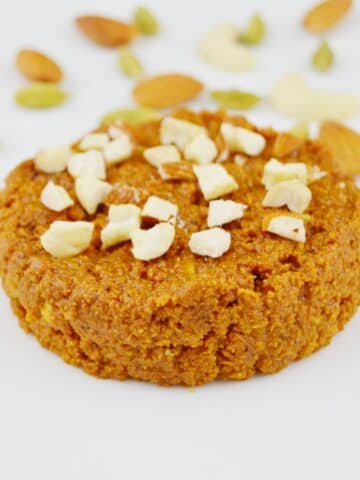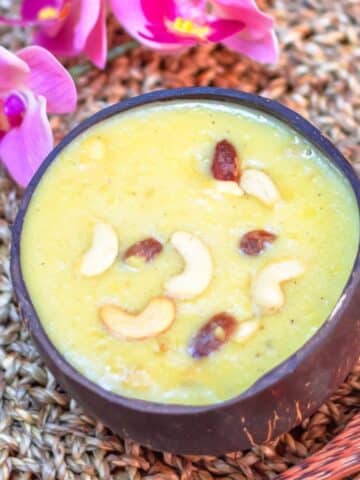Semiya Payasam - a classic south Indian dessert prepared using vermicelli, milk, sugar, flavoured with cardamom and garnished with nuts and raisins. It gets ready in less than 30 minutes.

The term 'semiya' means vermicelli and 'payasam' means pudding in south Indian language. Seviyan kheer, semiya kheer, shavige payasa, vermicelli payasam, sevai kheer are a few terms used in different parts of India to refer this sweet dish.

This south Indian sweet is often served at festivals and other special occasions such as religious ceremonies and weddings. Sweet pongal, payasam and medu vada are part of the festive feast in a few parts of Andhra and Tamil Nadu households on special occasions.
Jump to:
Typically I use a higher ratio of milk to vermicelli to prevent payasam from getting lumpy or excessively thick as it cools. This technique not only gets the right consistency but also ensures the vermicelli not sticking to each other.
Why we love this vermicelli pudding?
Gets ready in less than 20 minutes.
Easy to prepare with few ingredients
Perfect dessert to serve unexpected guests as it gets ready in less than 30 minutes.
What is payasam?
Payasam also termed kheer is a traditional Indian pudding made by simmering rice, lentils, broken wheat, tapioca, or vermicelli with milk and sweetener. It is flavoured with cardamom or saffron and garnished with fried nuts and raisins.
In many Indian homes, it is typically enjoyed as part of thali or as a dessert during festivals and other special occasions. There are various regional variations of payasam across India, each with its own unique ingredients and preparation methods. It is enjoyed both warm and cold.
Check out moong dal payasam, badam kheer, carrot coconut kheer and wheat payasam on the blog.

Wheat flour vermicelli is typically used to make semiya payasam. I used roasted vermicelli from the MTR brand for this recipe. If you decide to use raw vermicelli, be sure to roast it well until it turns aromatic and brown.
Ingredients

- Pantry Ingredients: Cashewnuts, raisins, almonds, salt, sugar and roasted vermicelli.
- Spices: Green cardamom powder.
- Dairy: Ghee and whole milk.
See the recipe card for quantities.
How to make semiya payasam?

Heat ghee in a pan over medium heat. Fry cashew nuts and raisins until they turn light golden brown.
Take them out into a bowl and set it aside to use later.

Now add the vermicelli and roast just for half a minute stirring regularly.

Reduce the heat to the lowest setting and add milk gradually stirring the vermicelli.
Simmer for around 8-10 minutes until the vermicelli is 70% cooked.

Stir occasionally to prevent vermicelli from sticking to the base of the pot.
Once the vermicelli is almost 70% cooked, add sugar and mix well.

Simmer for another 4-5 minutes or until vermicelli is soft and payasam thickens a little bit. (do not worry if payasam looks thin, it thickens further as payasam cools).

Now switch the heat off.
Now mix in fried cashews, raisins and cardamom powder and stir well.

Turn off the heat and let it cool for just a few minutes before serving.
Enjoy this creamy payasam as a flavourful end to any meal or on festive occasions!
Substitutions and Variations
Vegan Option: Use coconut milk to make a vegan version of Semiya Payasam. You can also substitute ghee with coconut oil or vegan butter.
Vermicelli: Instead of using wheat vermicelli, you can use other varieties such as ragi or millet vermicelli for gluten free option.
Sweetener: You could use jaggery instead of white sugar.
Clarified Butter: If pure ghee isn't available, you can substitute clarified butter, which is available in most supermarkets.
Serving Suggestions
Chilled or Warm: Semiya Payasam can be served either chilled or warm, depending on your preference. If serving chilled, refrigerate the payasam for a few hours before serving. If serving warm, serve it immediately after preparing it.
Accompaniments: Serve Semiya Payasam with traditional Indian savoury snacks such as murukku, murmura chivda or cabbage pakoda.
Thali: This is the most popular sweet served in most south Indian set meals or thali. Make it a part of your set meals - steamed parboiled rice, veg pulao, sambar, dosakaya pappu, cabbage poriyal, cucumber kosambari, pepper rasam, tomato pachadi, plain yogurt and payasam.

Storage
Fridge: Leftover semiya payasam can be stored in the fridge for up to 3 days. Transfer it to a clean and dry airtight container and pop it in the fridge.
Reheat: Place the required portion in a saucepan and reheat on the stovetop over medium heat until piping hot.
How to prevent payasam from turning super thick once it cools?
The thickening of payasam with cooling is a natural phenomenon. The incorrect ratio of milk to vermicelli is the primary cause of an overly thick payasam. So it is necessary to use a higher ratio of milk to vermicelli.
The ratio used in the recipe keeps payasam from becoming excessively thick after it cools. So don't worry if the payasam seems quite thin after cooking, it will thicken up as it cools and reaches the right consistency.
You could have a cup of boiled and cooled milk as a precaution. Keep an eye on the payasam as it cools. If you feel that it is becoming too thick, stir in the milk until it's well combined.
Make sure to gradually add the milk and stir the payasam with your other hand. Add just enough milk to get the desired consistency. This technique prevents further thickening of the payasam.
Tips and Tricks
Vermicelli: Various varieties of vermicelli ranging in thickness from thin to thick are available. Pick the preferred type, but remember the cooking time varies and depends on the thickness of it.
Roasting Vermicelli: I used ready-to-use roasted vermicelli, so I roasted it just for half a minute in ghee. If using raw vermicelli, roast it in ghee over medium-low heat for around 4-5 minutes, stirring frequently, until golden brown. It enhances payasam's flavour and taste. Make sure to stir it continuously for even roasting and to prevent burning.
Milk Ratio: The ratio of milk to vermicelli determines the consistency of the payasam. Use a higher ratio of milk to vermicelli to get flowing and creamy payasam.
Sweetness: Adjust the amount of sugar according to your taste preference. Remember that the sweetness will slightly reduce as the payasam cools down, so keep that in mind while adding sugar.
Nuts and Raisins: Fry the cashew nuts and raisins in ghee separately over medium heat before adding them to the payasam. Be careful not to burn them. Stir frequently until the nuts start browning and the raisins plump up.
Consistency: Although semiya payasam is roughly translated as pudding, it needs to have a flowing consistency rather than being super thick.
Milk: The payasam gets its creamy texture and flavour from whole or full fat milk. Although you could use fat-free or semi-skimmed milk, the payasam might not taste as creamy and flavorful.
Salt: Add just a tiny pinch of salt to enhance the flavour of other ingredients.
Stir Vermicelli: Be sure to keep stirring vermicelli with one hand while adding milk gradually with the other to prevent vermicelli from sticking to each other. Later on, it would be challenging to break the lumpy vermicelli.
FAQ
I wouldn't suggest freezing payasam as the dairy milk may separate during the process of thawing or reheating.
The vermicelli should be cooked until it is soft and tender, but not mushy. To test the texture, take a strand of vermicelli and taste or touch it.
It should be well-cooked and have a bit of a chewy texture when you taste it. It should feel soft and tender when you press a strand of vermicelli between your fingers. If it feels firm or crunchy, continue to cook for a few more minutes.
KEEP IN TOUCH
Do let me know if you make this traditional semiya payasam recipe. If you like this recipe kindly consider rating it using stars in the comment section or on the recipe card to help more people find this recipe online. You can stay up to date by following me on Facebook, Pinterest, Instagram or subscribing to my Youtube channel. Or why not subscribe to my blog and get simple recipes straight to your inbox?
📖 Recipe Card

Semiya Payasam (Vermicelli Kheer)
Ingredients
1 Cup = 250ml ; 1 Tablespoon = 15ml ; 1 Teaspoon = 5ml
Instructions
- Heat ghee in a pan over medium heat.3 Tablespoons Ghee
- Fry cashew nuts and raisins until they turn light golden brown.10 whole Cashews, 20 - 30 Raisins
- Take them out into a bowl and set it aside to use later.
- Now add the vermicelli and roast just for half a minute stirring regularly.1 Cup (or) 20 gms Roasted Vermicelli
- Reduce the heat to the lowest setting and add milk gradually stirring the vermicelli.4 Cups Whole Milk (Full Fat Milk)
- Simmer for around 8-10 minutes until the vermicelli is almost cooked.
- Stir occasionally to prevent vermicelli from sticking to the base of the pot.
- Once the vermicelli is almost cooked, add sugar and mix well.1 Cup (or) 215 gms Sugar, small pinch Salt (optional)
- Simmer for another 4-5 minutes or until vermicelli is soft and payasam thickens a little bit.
- Now switch the heat off.
- Now mix in fried cashews, raisins and cardamom powder and stir well.1 Teaspoon Cardamom Powder
- Turn off the heat and let it cool for a few minutes before serving.
- Pour payasam in a bowl, garnish with almonds and enjoy!5 Almonds
Notes
Nutrition
Related
Looking for other Indian dessert recipes? Try these:
More Pudding Recipes

Welcome to Flavours Treat. I share vegetarian recipes made with wholesome, mostly fresh ingredients. Every recipe has easy-to-follow instructions with process shots (detailed step-wise pictures), a short video and lots of tips to help your cooking journey. Read more














Leave a Reply